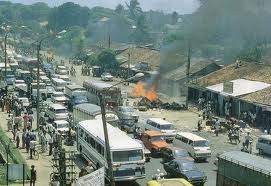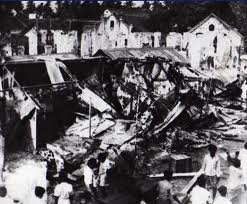 Forget the LTTE, forget even the Tamils. If you slaughter tens of thousands of people, if you treat the survivors like animals, if you do respect human dignity, then sooner or later you’ll pay that price. And I’m not talking of resurgence of terrorism. Sri Lankans already have the worst punishment: president Rajapaksa, a despot who rules the country like a private property. Sri Lankans decided to enslave themselves to the ultimate dinasty on the island.
Forget the LTTE, forget even the Tamils. If you slaughter tens of thousands of people, if you treat the survivors like animals, if you do respect human dignity, then sooner or later you’ll pay that price. And I’m not talking of resurgence of terrorism. Sri Lankans already have the worst punishment: president Rajapaksa, a despot who rules the country like a private property. Sri Lankans decided to enslave themselves to the ultimate dinasty on the island.
The issue is not about the Tamils. It is about impunity and lack of accountability. Clearly the Rajapaksa administration received a green light by the international community. The UN, the West, India let the Rajapaksas walk away after the slaughter of a city like Vavunya (according to UN)(according to the Bishop of Mannar, in his testimony for the LLRC, it is more likely a city like Kandy). What do you expect after that? Any other murder, any other disappearance is petty crime in comparison. The Sri Lankan citizens, all of them, have forget precisely this simple fact: how can you call for justice, after that?
What do you expect after that? Any other murder, any other disappearance is petty crime in comparison. The Sri Lankan citizens, all of them, have forget precisely this simple fact: how can you call for justice, after that?
Any misconduct, from threatening journalists, to assaulting judges, is trivial. Moreover, do you think the right of law can be exercised if you have skipped so quickly any investigation about the end of the war?
 The Sri Lankan citizens have been lured by their government, but also by a majoritarian ideology and a guilty sense of ownership over the island, that any dissent can be buried by any means. The LTTE started an armed struggle out of desperation. The leadership of Prabharakan soon spiralled in a vortex of violence for the sake of it; it was a response to the oppression and devastation of the Tamil culture and identity. Most important, the deranged trajectory of the LTTE didn’t represent and include all the Tamils. The elimination of 40 000 human beings is a crime of genocide. Forget Tamil Eelam: if you are a proud Sri Lankan, so proud that you’ll never consider the division of the country, then you must act immediately to seek the truth. To bring justice to human beings and to Sri Lanka, to the good name of Sri Lanka.
The Sri Lankan citizens have been lured by their government, but also by a majoritarian ideology and a guilty sense of ownership over the island, that any dissent can be buried by any means. The LTTE started an armed struggle out of desperation. The leadership of Prabharakan soon spiralled in a vortex of violence for the sake of it; it was a response to the oppression and devastation of the Tamil culture and identity. Most important, the deranged trajectory of the LTTE didn’t represent and include all the Tamils. The elimination of 40 000 human beings is a crime of genocide. Forget Tamil Eelam: if you are a proud Sri Lankan, so proud that you’ll never consider the division of the country, then you must act immediately to seek the truth. To bring justice to human beings and to Sri Lanka, to the good name of Sri Lanka.
 Poor Sri Lanka, if you think that killing innocents is a good way to honour your country, if you think that the blood of children, elderly and armless unfortunate, is a good way to worship this Buddhist soil.
Poor Sri Lanka, if you think that killing innocents is a good way to honour your country, if you think that the blood of children, elderly and armless unfortunate, is a good way to worship this Buddhist soil.
Are you really convince that a Buddha will be pleased by this bloody sacrifice, that to hold a flag in his name, you had to rape, torture and massacre thousands? In what kind of hell have you fallen, my poor Sri Lanka.





















